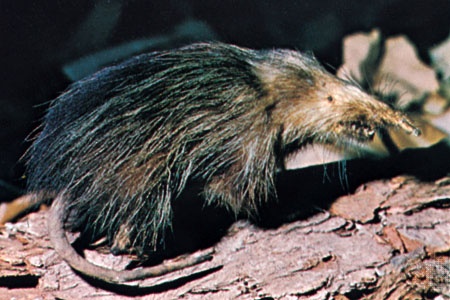solenodon
mammal family
 either species of large shrewlike mammal found only on the islands of Cuba and Hispaniola. Solenodons have a chunky body with short, stocky legs. Various skin glands give it a goatlike odour. The elongate head has very small eyes and tapers to a long, flexible snout adorned with long whiskers. Its saliva is toxic and enters the prey as the solenodon bites with its incisors. Solenodons weigh 800 to 1,100 grams (1.8 to 2.4 pounds) and have a body 28 to 39 cm (11 to 15 inches) long and a shorter tail of 18 to 26 cm. The coarse fur is dark brown to reddish brown or blackish on the head and back and whitish or buff on the sides. The tail and feet are scantily haired.
either species of large shrewlike mammal found only on the islands of Cuba and Hispaniola. Solenodons have a chunky body with short, stocky legs. Various skin glands give it a goatlike odour. The elongate head has very small eyes and tapers to a long, flexible snout adorned with long whiskers. Its saliva is toxic and enters the prey as the solenodon bites with its incisors. Solenodons weigh 800 to 1,100 grams (1.8 to 2.4 pounds) and have a body 28 to 39 cm (11 to 15 inches) long and a shorter tail of 18 to 26 cm. The coarse fur is dark brown to reddish brown or blackish on the head and back and whitish or buff on the sides. The tail and feet are scantily haired.Found in habitats ranging from forest to scrubland, solenodons are terrestrial, although they are able to climb. On the ground they travel in an irregular path with a waddling gait but can run fast for short distances. Solenodons forage at night for invertebrates by probing leaf litter and soil with their long snout and tearing apart rotten tree trunks with their powerful front feet and long, sharp claws. Land crabs and snails, frogs, lizards, snakes, and bird eggs are also eaten. Solenodons require much water.
Burrows are excavated in deep humus, but rock crevices, caves, and hollow tree trunks on the ground are also used as shelters. The Cuban solenodon (S. cubanus) is social, with several animals living together in the same burrow. They communicate with twitters, chirps, squeaks, squeals, and clicks. Adult solenodons approach each other with open mouths, perhaps emitting high-frequency clicks. Contact then often results in one animal's closing its mouth over the snout of the other. One or two young are born per litter. This species once occurred throughout Cuba but now survives only in the southeastern portion of the island. The Hispaniolan solenodon (S. paradoxus) lives in Haiti and the Dominican Republic.
Two recently extinct species of solenodon have been described. Skeletal remains of Marcano's solenodon (S. marcanoi) were found in the Dominican Republic and Haiti. It must have become extinct after AD 1500 because the bones were associated with those of house rats (Rattus rattus), which were introduced to Hispaniola by Europeans. The giant solenodon (S. arredondoi) is represented by partial skeletons from western Cuba. Whether it survived after AD 1500 is unknown, as the bones may date to the Pleistocene Epoch (1,800,000 to 10,000 years ago) or the Holocene Epoch (10,000 years ago to the present). This large solenodon might have been a half-metre (1.6 feet) long and weighed perhaps 2 kg (4.4 pounds). The giant and Cuban solenodons may have been the only large mammalian predators on the island before human occupation.
Solenodons make up the family Solenodontidae (order Soricomorpha), which belongs to a larger group of mammals referred to as insectivores (insectivore). Although classified in the same order as shrews (family Soricidae), solenodons are only distantly related to them and do not have any close living relatives. Solenodons appear to be island remnants of an evolutionary diversification that included shrewlike members of the extinct family Apternodontidae. These are represented by North American fossils, some of which date to the Paleocene Epoch (65 to 54.8 million years ago).
- Cartwright, Alexander Joy
- Cartwright, Edmund
- Cartwright, John
- Cartwright, Peter
- Cartwright, Sir Richard John
- Cartwright, William
- Caruaru
- Carus
- Caruso, Enrico
- Carvajal y Mendoza, Luisa de
- Carvaka
- carvel construction
- Carver chair
- Carver, George Washington
- Carver, John
- Carver, Jonathan
- Carver, Raymond
- Carver, Robert
- Cary, Annie Louise
- caryatid
- Cary, Elisabeth Luther
- Cary Grant
- Cary, Henry Francis
- Cary, Joyce
- Caryl Chessman